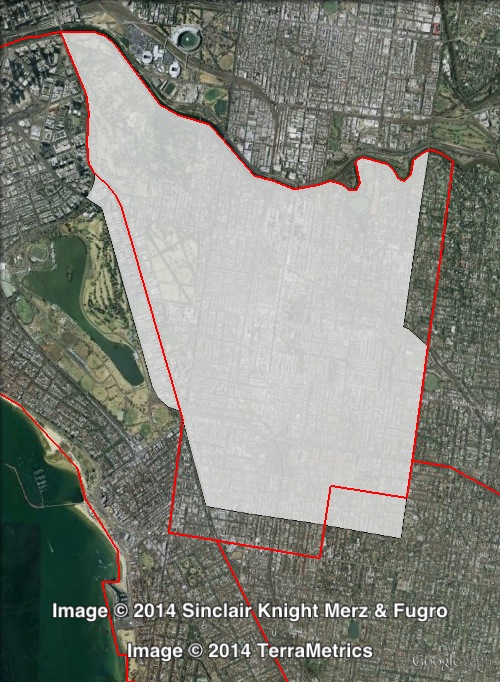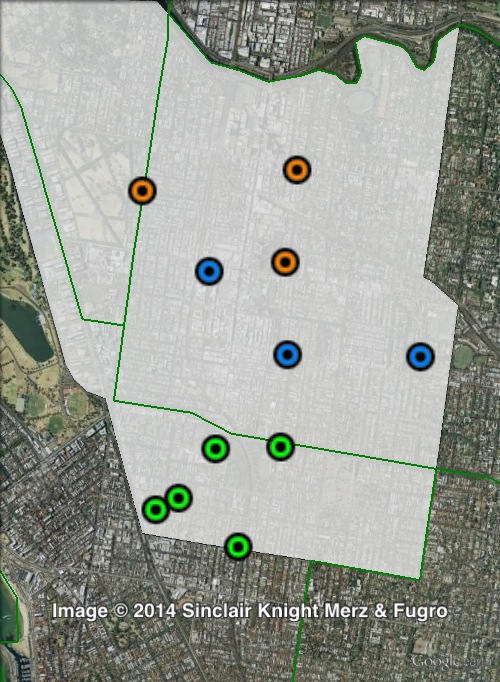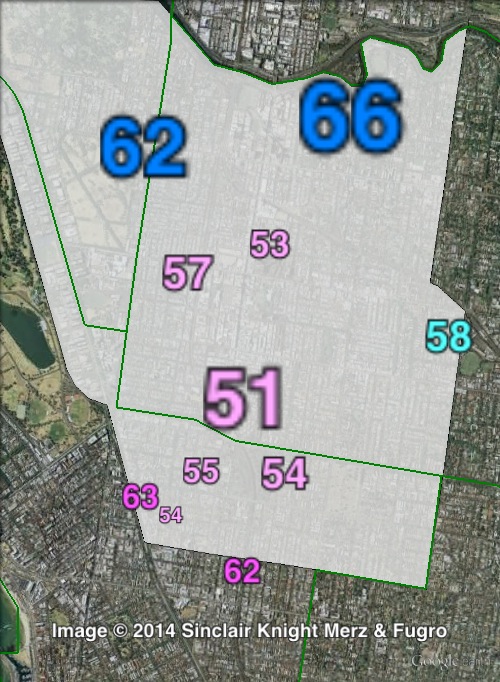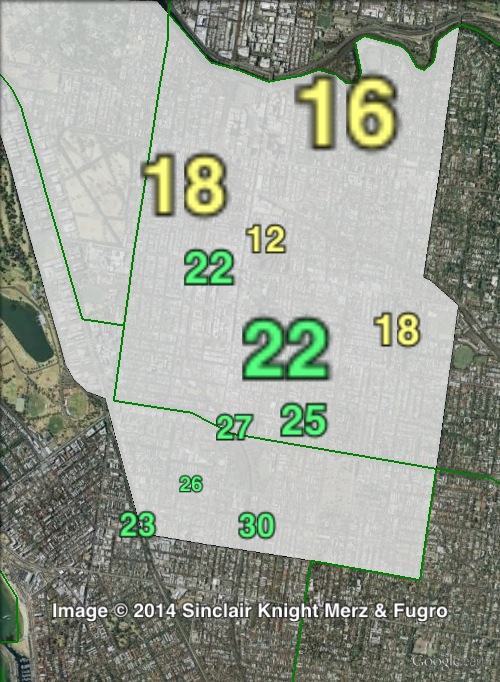LIB 4.7%
Incumbent MP
Clem Newton-Brown, since 2010.
Geography
Inner southern Melbourne. Prahran covers the suburbs of Prahran, South Yarra and Windsor and parts of St Kilda and Toorak.

Redistribution
Relatively minor adjustments were made to Prahran’s southern, eastern and western boundaries, which increased the Liberal margin from 4.3% to 4.7%.
History
Prahran has been a state electorate since 1889. It has alternated between the ALP and conservative parties, but in recent decades has been dominated by the Liberal Party.
The ALP first won the seat in 1894, holding it until 1900. Liberal MP Donald Mackinnon held the seat from 1900 to 1920. The ALP and conservative parties alternated in control until the 1930s, with the Liberal Party holding the seat until 1945.
In 1945, the ALP’s William Quirk won the seat, holding it until his death in November 1948. The ensuing by-election in 1949 was won by Frank Crean, who had previously held the seat of Albert Park. He left the seat in 1951 when he moved to the federal seat of Melbourne Ports. He served as a federal MP until 1977, playing a senior role in the Whitlam Labor government.
The 1951 Prahran by-election was won by the ALP’s Robert Pettiona, who held the seat until his defeat in 1955.
Since 1955, Prahran has been won by the ALP only four times. In 1955, the seat was won by Sam Loxton, a Liberal candidate. Loxton was a former test cricketer who had been part of Don Bradman’s Invincibles team and played VFL football for St Kilda.
Loxton held the seat until 1979, when the ALP’s Bob Miller won the seat. He held the seat for two terms, and in 1985 unsuccessfully contested the Legislative Council province of Monash.
The Liberal Party’s Don Hayward won the seat in 1985. He had previously held the upper house seat of Monash from 1979 to 1985. He served as Member for Prahran until the 1996 election.
In 1996, the Liberal Party’s Leonie Burke won Prahran. Burke was defeated in 2002 by the ALP’s Tony Lupton. Lupton was re-elected in 2006.
In 2010, Lupton was defeated by Liberal candidate Clem Newton-Brown.
Candidates
- Sam Hibbins (Greens)
- Alan Walker (Family First)
- Neil Pharaoh (Labor)
- Jason Goldsmith (Independent)
- Steve Stefanopoulos (Independent)
- Clem Newton-Brown (Liberal)
- Eleonora Gullone (Animal Justice)
- Alan Menadue (Independent)
Assessment
Prahran is a marginal electorate. While the seat in the past has trended to the Liberal Party, the seat has quite a strong centre-left vote, including a high Greens vote. If Labor and Greens both poll strongly and preference flow tightly, Clem Newton-Brown could be in trouble. Despite the statewide trend, Newton-Brown should benefit from a new personal vote.
2010 election result
| Candidate | Party | Votes | % | Swing | Redist |
| Clem Newton-Brown | Liberal | 16,197 | 47.95 | +6.08 | 45.56 |
| Tony Lupton | Labor | 9,384 | 27.78 | -8.94 | 28.70 |
| Meni Christofakis | Greens | 6,685 | 19.79 | -0.34 | 20.58 |
| Christian Vega | Sex Party | 1,073 | 3.18 | +3.18 | 3.33 |
| Katharine Anderson | Independent | 239 | 0.71 | +0.71 | 0.66 |
| Simon Ronchi | Family First | 198 | 0.59 | -0.69 | 0.64 |
| Other independents | 0.53 |
2010 two-party-preferred result
| Candidate | Party | Votes | % | Swing | Redist |
| Clem Newton-Brown | Liberal | 18,333 | 54.28 | +7.83 | 54.70 |
| Tony Lupton | Labor | 15,443 | 45.72 | -7.83 | 45.30 |

Booth breakdown
Booths in Prahran have been divided into three parts: north, south and central.
The Liberal Party won a solid 61% majority in the north, while Labor won a solid 57.7% majority in the south, and a slim 50.6% in the centre of the electorate.
The Greens came third, with a vote ranging from 16.2% in the north to 26.1% in the south.
| Voter group | GRN % | LIB 2PP % | Total | % of votes |
| North | 16.17 | 60.97 | 6,674 | 20.72 |
| Central | 20.96 | 49.37 | 5,358 | 16.63 |
| South | 26.12 | 42.35 | 5,099 | 15.83 |
| Other votes | 20.52 | 53.58 | 15,080 | 46.82 |




Miller moved in 1985 because redistribution made it notationally Liberal. Fact that Libs held it easily in 1999 makes me think it’s sort of seat that likes ‘liberal Libs’, the recent publicity for Liberal social conservatives won’t help their cause here. Greens sometimes dream they could outpoll Labor here
Labor has an excellent candidate here. Keep an eye on it on election night.
The Greens are putting a lot of effort and resources into this seat. The Greens do have a chance (chance not certainly) of overtaking the ALP. This really will be a seat to watch on election night and the days after as this is a three-way race with the only certainty being the Liberals will not come third.
The Greens have done well here, but it’s a fantasy to think they can challenge this year. If the Labor vote falls (unlikely, let alone enough to fall behind the Greens), then the Libs would have done enough to win it on primaries.
Sophmore surge will save the libs here, one of the seats they gained most likely to stay
My seat. Newton-Brown is a high profile and popular small l Liberal MP and has been very active locally. I expect him to comfortably retain the seat.
Miller was highly regarded in Prahran and some say he could have held on to it. He became despondent, He lost Monash by just 200 votes. The Liberal party handed out a sham HTV card “Save Prince Henry Hospital” Placing the Liberal Candidate first and told voters they had placed Miller second. This ticket and the donkey vote most likely costs Miller the seat of Monash. had he won Monash the Labor Party would have held control of the Upper-house and Nunawading would have been a footnote in the electoral stats
Prahran is the only inner Melbourne State seat that has changed parties. So finely tuned the electorate is susceptible to boundary changes. Planning and Traffic being the two main issues along with Social Issues of the day. It is without a doubt the most diverse and dynamic seats in Victoria. Gentrification, higher education and rising property values has transformed Prahran from a inner city working class suburb to a conservative electorate. The changes are most notable when you look at photos of the Prahran Market over the decades,
Former ALP Deputy PM, Jim Cairns, use to be a regular at the Prahran Market
Also nominated here is independent Alan Menadue
Steve Stefanopoulos has a Facebook page here
http://www.facebook.com/pages/Steve-Stefanopoulos-for-Prahran/392995187519504
Ive just noticed the meme of the Greens winning this seat. It *is* possible, but even a very small swing of say 3% to Labor (which is pretty realistic would mean there just arent enough votes. Not sure who comes up with these things even if I do appreciate the enhusiasm.
It’s a brave move for the Greens to have targeted this seat, and inevitably they would be criticised either way by some. I think it reflects a desire for the Greens to be seen as not trying to win seats off Labor all the time, and instead be seen as trying to help build a ‘centre-left’ majoirty by targeting a Liberal-held seat. If they end up narrowly losing Melbourne, Richmond et al I’m sure there’ll be criticism of the diversion of resources here, but I do see the rationale behind the strategy. Personally I really don’t know what I think of the strategy. I won’t be criticising the Vic Greens either way this turns out.
There is some similarity here with Balmain in NSW where the party who comes second in primary vote because of a big swing away from the Government will probably win. There in Balmain it was the Greens in # 2 spot here probably Labor. It might be more interesting next election if Labor is in government and they experience a big swing against them.
Except Balmain is safely non-Liberal, whereas Prahran is a genuine marginal. The Libs topping the Balmain primary vote was a feature of the 2011 landslide, not a normal occurrence.
The Greens have a small advantage in Prahran in than they get Animal Justice Party preferences* and the Liberals, rather than the ALP, get Family First preferences* (not that there were many of them). The other 3 candidates had not registered hot to vote cards and have a very small vote each anyway and will probably scatter around.
* Except for leakage, which will probably be quite low.
Very unusual outcome.
Depending on the different percentage of votes that flow between Greens and Labor it can actually be strategic for a Liberal voter to vote for one of those two parties 1 and Liberal 2 just to stop the other from getting into 2nd place (so long as they dont push there own party too low). I dont think ive noticed strategic voting work with preferences before.
That would only be the case if the Libs were likely to do much better against the Greens than against Labor, or vice versa. In all likelihood though the Lib 2PP would be much the same against either opponent.
My article on the Prahran postcount is here:
http://kevinbonham.blogspot.com.au/2014/11/victorian-election-postcount-prahran.html
I find my view of it is changing a lot as more figures come in. At first I thought Hibbins would probably beat Pharaoh and that Newton-Brown would probably beat either. After Pharaoh’s stellar performance on within-electorate prepolls I thought he was well placed to stay ahead of Hibbins and beat Newton-Brown. Now the evidence is moving back towards a good chance Hibbins beats Pharaoh after AJP preferences, but then I don’t know what happens between Hibbins and Newton-Brown. (At present Hibbins would need 84.2% of preferences and I think that’s a bit ambitious, but his asking rate could well come down after absents.)
A good example of where tactical voting would have mattered in a lower house is Frome by-election 2009. Brock beat Labor by 30 votes so if 31 who voted Liberal had tactically voted 1 Labor 2 Liberal then the Liberals would have won the seat. Another one was Denison 2010 (federal) where Wilkie narrowly got over the Liberal candidate. Liberals had an incentive to vote 1 Wilkie because he could beat Labor but their guy couldn’t. Labor voters had an incentive to vote 1 Liberal 2 Labor for exactly the same reason.
@ David Walsh
There are a few interesting scenarios.
Normally if you want a party to come last then you put them last and you put the party you support most first and number the rest in declining order.
In this seat if youre a Liberal voter who really doesnt want one of Labor or the Greens to win youre safer abandoning your 1st preference to the other keeping your 2nd for Liberal and ofcourse putting your least liked party last. This flys in the face of the result in probably every other seat in the state. Its really only possible IF the results are close (which they are here) and you really dont want one of the parties to win enough to give up your chances of your preferred party.
The 2nd and subsequent scenarios are just variants of each other.
The Liberals win on primary vote and the difference between their vote and 50% +1 is substantial enough that the few votes you will switch make no difference. The Greens and Labor finish first and third, but there needs to be a very small difference between their votes ideally just one in the best case scenario. Labor votes flow to Greens or Liberals at a certain percentage and Greens to Labor or Liberal at a certain percentage. If you only have to change a few of your votes to get your preffered second place party then you should do it.
Im sure someone more into maths will be able to come up with an actual formula for this where you can set all these values.
Ill have a look when we have the final vote and see if a few Liberal voters could have disproportionately influenced the result.
The ‘Greens and Labor finish first and third’
This should be second and third.
Regardless of the end result – I don’t think that anyone can credibly continue to claim that the Greens only take on the ALP at elections.
Hardly. All the Greens are doing in Prahran is potentially replacing Labor as the main contender to the Liberal Party. For the most part they are not taking votes off the Libs.
How do you figure, that, David? We seem to be a swing off both majors on primaries in Prahran (unless you think that all the fall in the Liberal Primary is going to the Animal Justice party, of course).
Looks like game over for Labor here after absents pushed Newton-Brown’s lead out to 265. We still don’t have full primaries to see if the Greens can nab second but I’m inferring it is probably academic.
The seat would be an ALP seat if it wasnt Green though. With compulsory voting the reality is many of the Green voters would have voted Labor.
You can see how the seat would likely play out without the Greens or Labor by the preferences and how many Green voters go on to preference Labor and how many Liberal voters go on to preference Labor or Greens.
Polly, the Liberal Party vote dropped everywhere this election. Prahran was already a seat they were vulnerable to losing in a bad election, with or without a strong Greens presence.
The above maps from 2010 explain it well. The Greens are strongest where Labor is strongest.
Yes, but this time in Prahran, the Liberal vote dropped, but the ALP vote also dropped on the booths on the day. So where did that Liberal vote go to in Prahran? It looks like we’ve improved our vote across all booths in Prahran, not just the southern ones. Both the ALP (his may be a very small swing once all the non-booth votes are counted) and the Liberals suffered swings against them on their primary vote, so it looks like the Greens have gained voters off both major parties. Also, my original point stands. It’s often claimed that the Greens only target ALP held seats, but we targeted Prahran, and have done very well here and turned it into a genuine 3 cornered contest.
The Greens target seats where the ALP is vulnerable to its left. In this sense Prahran is not much different to Melbourne or Richmond, it just also happens to have a large conservative component.
The Greens are perfectly entitled to compete for these seats of course. But Prahran hardly represents a new vulnerability for the Liberal Party. It was already one of their most marginal seats.
By the way, we have no way of knowing what votes went where. All we know is the net change in each parties’ tally.
Firstly, the Liberal vote going down is not evidence that those people switched to the Greens. It’s entirely possible that they switched to Labor and were offset by more people switching from Labor to the Greens.
Also there are Labor voters all over the electorate, including in strong Liberal areas, who could switch. I expect there is more evidence to help us determine if the Greens gained their votes from Labor or Liberal by looking at the booth results. I haven’t had a chance, but might look into it on the weekend.
Likewise, I think there is a strong preference flow from Greens to Labor which suggests that most of those Greens voters are centre-left voters, rather than Liberals flipping to the Greens.
I’ve always thought the criticism of the Greens about targetting Labor seats is ridiculous – Greens campaign effort isn’t fungible and they can’t just transfer their efforts from a strong seat to a weak seat and win there.
However if you do accept that argument, I don’t really see the difference with Prahran. While it is a Liberal seat, it’s a Liberal seat that has until recently been held by the ALP and Labor would have had a good chance of winning without the Greens targetting the seat.
It’s hard to tell whether the Greens’ targetting Prahran hurt Labor by diverting energy and through preference leakage, or it helped Labor by generally strengthening the centre-left and giving one of the two parties a chance of winning. But if you think that Labor would have been likely to win Prahran without the seat being a key Greens target seat, then the Greens campaign is just as much taking a seat away from Labor as they do by targetting Melbourne or Richmond or Brunswick.
As I said, it’s an impractical criticism of the Greens mostly made by people who don’t have the Greens best interests at heart, but I think the criticism is made no less valid by targetting Prahran.
Good points, Ben, and of course it’s hard to say that there isn’t some vote transfer going on (I think you cant just assume there is, though)- I don’t think that’s the sort of thing you can easily measure either way, but I’d be interested in your thoughts on how it could be measured (and when it should be assumed that votes have come off the ALP to the Greens, while the ALP picks up libs votes – it seems to be a big assumption that the Greens can never pick up socially progressive liberal votes directly, and that these votes have to go via the ALP). Of course Prahran has flipped between both parties historically, so it’s not a safe seat for anyone.
Suspect Prahran like Wentworth federally would have more Liberal-Green swinging voters than most other seats.
@Geoff – that’s what I suspect, too. It’s a different kind of a liberal voter – more genuinely liberal, and less conservative.
Contra to my comment above I don’t now think it’s academic at all whether the Greens can get into second – the share of Absent votes in what was left was higher for the Greens than I expected and they tend to do well on those. So until we see more rechecked primaries + find out exactly where we’re at, the chances of the Greens being in a winnable position if they make the final two have to be taken seriously. Rechecked primary count is still about 5K behind where the primary count was before taken offline for rechecking.
Only 11 votes between them today!
Will be interesting to see whether a proper distribution of minor party prefs gets the Greens ahead of the ALP. I suspect Greens will get a higher percentage of ALP prefs than the ALP got from Greens voters.
Liberal now 25 votes ahead of ALP, ALP 411 votes ahead of Green – according to ABC